The Saudi construction landscape is transforming at a remarkable pace, with Vision 2030 projects stretching from the Red Sea coast to the Rub’ al Khali desert. In this dynamic environment, traditional concrete production methods are being reevaluated, giving rise to innovative foundation-free stationary concrete plants that combine mobility with industrial-scale output.
These self-contained units are revolutionizing how contractors approach concrete supply, particularly in remote locations and temporary project sites where permanent infrastructure would be impractical or cost-prohibitive. Their growing adoption reflects a fundamental shift in Saudi Arabia’s construction philosophy—one that prioritizes adaptability without compromising quality or production capacity.

Accelerated Project Timelines Demand Rapid Deployment
Saudi Arabia’s giga-projects operate on ambitious schedules that leave little room for lengthy plant installation. Foundation-free concrete ready mix plants eliminate weeks of civil works typically required for traditional batching facilities, becoming operational within days rather than months. This swift deployment capability proves invaluable for projects with phased construction plans or those requiring temporary production hubs at multiple locations. The ability to relocate entire plants with minimal downtime ensures continuous concrete supply aligns perfectly with the Kingdom’s fast-track development approach. Modern units feature pre-assembled modules with plug-and-play functionality, reducing setup complexity while maintaining production precision—a critical factor when working against tight deadlines.

Overcoming Geographic and Environmental Challenges
The Kingdom’s diverse terrain—from coastal regions to arid deserts—presents unique obstacles for concrete production. Foundation-free concrete batching plants in Saudi Arabia thrive where conventional systems struggle, requiring no permanent footings or complex site preparation. Their modular designs incorporate advanced stabilization systems that maintain operational integrity on shifting sands or uneven ground. Dust suppression technology and heat-resistant components ensure reliable performance in harsh desert conditions, while compact footprints allow installation in space-constrained urban sites. These plants also address water scarcity concerns through closed-loop recycling systems that minimize consumption—an essential feature in a region where every resource must be carefully managed. By conquering Saudi Arabia’s environmental extremes, these mobile production units are rewriting the rules of concrete supply logistics.
Cost Efficiency Meets Strategic Flexibility
The economic advantages of foundation-free plants extend far beyond reduced civil works expenses. Their modular nature allows capacity scaling to match project requirements, preventing the capital lock-in associated with permanent facilities. Contractors can right-size their production assets for each project phase, then reconfigure or relocate as needs evolve—a crucial benefit in Saudi’s dynamic construction market. Energy-efficient designs with hybrid power options slash operational costs, while standardized components simplify maintenance across multiple sites. Perhaps most importantly, these plants transform concrete production from a fixed cost center into a mobile strategic asset that can be deployed where market opportunities emerge, giving forward-thinking contractors a competitive edge in bidding for diverse projects across the Kingdom.

As Saudi Arabia continues its unprecedented construction boom, foundation-free batching plants for sale are proving to be more than just temporary solutions—they represent the next evolution in responsive, efficient concrete production. By eliminating traditional barriers to rapid deployment and relocation, these systems align perfectly with the Kingdom’s vision of agile, sustainable development. Their growing prevalence across NEOM, Qiddiya, and other Vision 2030 projects demonstrates how innovation in concrete technology is supporting innovation in construction itself. For contractors navigating Saudi Arabia’s complex and fast-moving building landscape, these desert-proven plants offer both project-ready solutions today and a blueprint for adaptable infrastructure tomorrow.